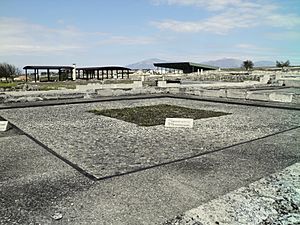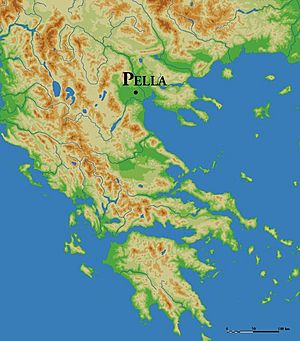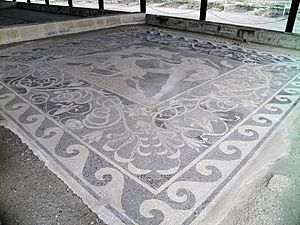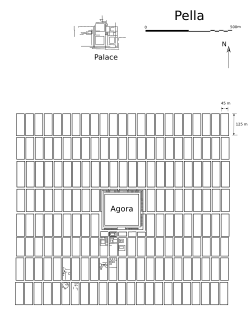Pella facts for kids
|
Πέλλα
|
|
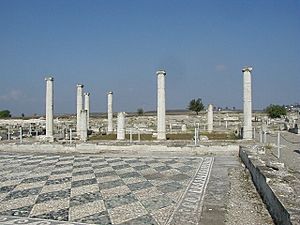
Atrium with a pebble-mosaic paving in Pella
|
|
| Lua error in Module:Location_map at line 420: attempt to index field 'wikibase' (a nil value). | |
| Location | Macedonia (Greece) |
|---|---|
| Type | Settlement |
| History | |
| Cultures | Ancient Greece |
| Site notes | |
| Website | pella-museum.gr |
Pella (Greek: Πέλλα) is an ancient city in Central Macedonia, Greece. It was once the important capital of the ancient Greek kingdom of Macedon. Pella is also famous as the birthplace of Alexander the Great, one of history's most famous leaders. Today, you can visit the Archaeological Museum of Pella at the site of this historic city.
Contents
What Does the Name Pella Mean?
The name Pella likely comes from an ancient Greek word. This word, pélla (πέλλα), means "stone." You can see this word in other Greek place names, like Pallini. Some people think it might have meant "wooden bowl" at first, then later "stone." It could also relate to apella, meaning a stone fence or enclosure.
Pella's Journey Through Time
In ancient times, Pella was a busy port city. It was connected to the Thermaic Gulf by a waterway. Over many years, the harbor and gulf filled with dirt and sand. This left Pella far from the sea, making it a landlocked city today.
Early Mentions of Pella
The historian Herodotus first wrote about Pella. He mentioned it during the Persian King Xerxes' campaign. Another historian, Thucydides, also wrote about Pella. He described its role in the expansion of Macedon.
Pella Becomes a Capital City
Pella likely became the capital of Macedon under King Archelaus I. He moved the capital from the older city of Aigai. King Archelaus invited famous artists to Pella. The painter Zeuxis decorated his palace. The playwright Euripides also lived and wrote here. His play Bacchae was first performed in Pella around 408 BC.
By the early 4th century BC, Pella was the largest city in Macedon. It was the birthplace of two very important figures:
- Philip II of Macedon, born in 382 BC.
- Alexander the Great, Philip's son, born in 356 BC.
Pella's Golden Age
Pella grew into the richest and largest city in Macedon. It especially thrived under the rule of Cassander. The city's greatest prosperity was probably during the reign of Antigonus II Gonatas. Many archaeological finds come from this time. The famous poet Aratus died in Pella around 240 BC.
Pella and the Romans
Pella was the capital during the Macedonian Wars. These wars were fought against the Roman Republic. In 168 BC, the Romans took over Pella. They sent its treasures back to Rome.
A Roman general named Lucius Aemilius Paullus Macedonicus described Pella in 167 BC. He noted its strong defenses. The city was on a hill, surrounded by a deep marsh. The citadel, called "Phacus," was like an island in the marsh. It was connected to the city by a bridge. This made it very hard for enemies to attack.
Pella became a Roman administrative center. It was an important stop on the Via Egnatia, a major Roman road. This road connected Dyrrachium and Thessalonika.
Decline and Rebuilding
Around 90 BC, a big earthquake hit Pella. Shops and workshops were destroyed. But the city was later rebuilt on top of its ruins. Even though it was rebuilt, the main Roman government seat moved to Thessalonika.
Pella became a Roman "colony" between 45 and 30 BC. This meant it had special status. However, its importance quickly faded. Writers like Dio Chrysostom and Lucian described Pella as being in ruins. While they might have exaggerated, the city did decline. The Roman city was actually a bit west of the original capital. Even so, people lived in the southern part of Pella until the 4th century AD.
By 180 AD, Lucian described Pella as "now insignificant, with very few inhabitants." Later, it was known as Diocletianopolis. During the Byzantine period, a fortified village stood on the Roman site.
Modern excavations began in 1957. They have uncovered large, well-built houses. These homes had courtyards with columns and rooms with beautiful mosaic floors. Some mosaics show scenes like a lion hunt or Dionysus riding a panther. Today, the Alexander The Great Marathon starts in Pella. This honors the city's ancient history.
Discovering Ancient Pella: Archaeology
Archaeologists have been exploring Pella for a long time. The first official excavation started in 1914. Since 1953, systematic work has continued. This has revealed many parts of the large ancient city.
Important Discoveries
In 2006, a farmer accidentally found the largest tomb ever in Greece. It belonged to a noble ancient Macedonian family. Inscriptions and painted walls survived inside. This tomb dates back to the 2nd or 3rd century BC.
Since 2000, archaeologists have found over 1,000 tombs. However, this is only about 5% of the total site. In 2009, 43 graves were found with many valuable items. In 2010, 37 more tombs were discovered. These date from 650 to 280 BC. They contained ancient Macedonian artifacts, from pottery to precious metals. One tomb held a warrior from the 6th century BC. He was buried with a bronze helmet, weapons, and jewelry.
Many of these amazing artifacts are now on display at the Archaeological Museum of Pella.
How Pella Was Planned
The city of Pella was built using a special design called a grid plan. This plan was created by Hippodamus of Miletus. It means the city had straight streets that crossed each other at right angles. This created a grid of rectangular blocks.
The blocks were about 45 meters wide. Their length varied, but 125 meters was common. Most streets were 9 to 10 meters wide. One main east-west street was wider, up to 15 meters. This wide street led to the central public agora (marketplace). The agora covered a huge area, about 7 hectares. Two north-south streets were also wider. They connected the city to the port.
This type of city plan dates back to the early 4th century BC. Pella was one of the first cities known to have a piped water supply. Many houses had running water, and the city had a waste water system.
Inside the City Walls
Pella was built on a promontory (a piece of land sticking out into the sea). This land was once an island called Phacos. The city wall, mentioned by the historian Livy, is partly known. It was made of crude bricks on a stone foundation.
The Agora, or marketplace, was at the heart of the city. It was built in the late 4th century BC. It was a unique and huge architectural wonder. The agora was surrounded by shaded walkways called stoae. The city also had houses with frescoed walls and inner courtyards. Some of these walls used trompe-l'oeil techniques. This made them look like they had depth and perspective.
Pella had temples dedicated to gods like Aphrodite, Cybele, and Demeter.
Famous Mosaics
Pella is especially famous for its pebble-mosaic floors. These beautiful mosaics decorated the floors of wealthy homes. Some of them copied famous Greek paintings. One mosaic shows a lion-griffin attacking a stag. Another shows Dionysus riding a leopard. These mosaics are so well-known that houses are often named after them, like the Houses of Helen and Dionysus.
The Royal Palace
The royal palace was located on the central hill, overlooking the city. It was a very large complex, possibly covering 60,000 square meters. The palace had several large sections. Each section had rooms built around a central courtyard, often with columns. Archaeologists have found a palaestra (a wrestling school) and baths within the palace.
The front of the palace, facing the city, had a huge portico (a long walkway with columns). This portico was at least 153 meters long. It was built on a 2-meter-high foundation. A grand entrance with three gates, 15 meters high, made the palace look very impressive from the city below.
The palace was not just a home for the king. Its large size suggests it was also a center of government. It housed many of the people who helped run the kingdom.
What Language Did They Speak in Ancient Pella?
People have long wondered what language was spoken in ancient Macedon. A very important discovery was made in Pella in 1986. It was a lead tablet called the Pella curse tablet. This tablet has writing on it from the early 4th century BC.
The writing on the tablet is in a specific Greek dialect called Doric Greek. This tablet is one of four texts found so far that show a local dialect of ancient Greek in Macedon. All of them are Doric. This discovery helps confirm that a Doric Greek dialect was spoken in Macedon. It supports the idea that the Ancient Macedonian language was a dialect of North-Western Greek, which is part of the Doric dialects.
See also
 In Spanish: Pela (Grecia) para niños
In Spanish: Pela (Grecia) para niños


